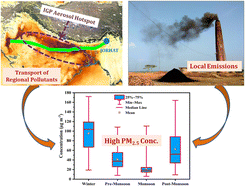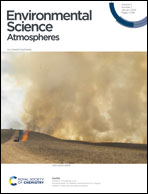Year-long evaluation of aerosol chemistry and meteorological implications of PM2.5 in an urban area of the Brahmaputra Valley, India†
Abstract
Atmospheric particulate matter (e.g., PM2.5) contributes to deteriorating air quality, causes respiratory and cardiovascular diseases, and risks human health. In this study, we evaluated the mass concentrations and chemical compositions of PM2.5 in an urban area of Northeast India to determine their seasonal variations and the influence of meteorological factors on PM2.5. PM2.5 was sampled in multiple filter substrates; the water-soluble inorganic ions (WSIs), elemental compositions, and organic carbon (OC)-elemental carbon (EC) were determined by using an ion chromatograph, an energy dispersive X-ray fluorescence spectrometer, and a multi-wavelength thermo-optical carbon analyzer, respectively. The annual mean PM2.5 concentration (48.9 ± 37.7 μg m−3) was observed to be approximately ten times higher than the prescribed WHO safe limit (i.e., 5 μg m−3). The results show that the PM2.5 mass is mainly contributed by WSIs (∼30%), carbonaceous matter (∼21%), and inorganic elements (∼9%). Seasonal analysis also shows the highest concentration of PM2.5 in the winter season (95.3 ± 37.9 μg m−3), which was mainly contributed by the WSIs (22.7 ± 8.1 μg m−3) and carbonaceous matter (26.9 ± 13.9 μg m−3). Also, high concentrations of SO42−, NO3−, and soot-EC were found during the winter, indicating the dominance of coal combustion and vehicular source emissions in the region. Meteorological factors such as humidity, wind speed, and temperature along with the transport of regional air masses significantly influenced the PM concentrations of the Brahmaputra Valley in Northeast India within the Indo-Gangetic Plain (IGP). The study implies the necessity of paying attention to the local emission sources and the meteorological conditions in such growing urban areas for improving air quality.

- This article is part of the themed collection: Environmental Science: Atmospheres: Highlight India


 Please wait while we load your content...
Please wait while we load your content...